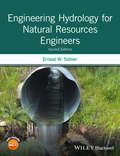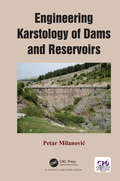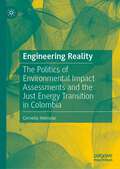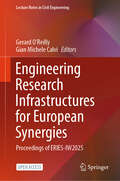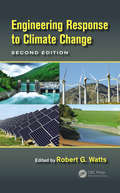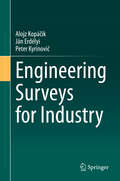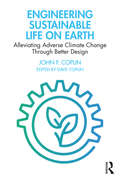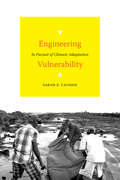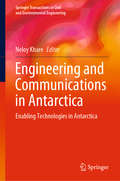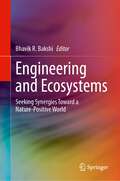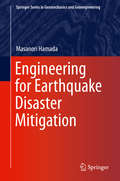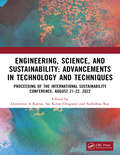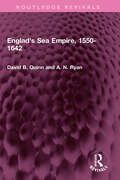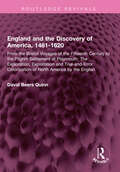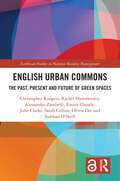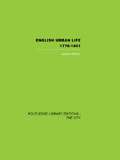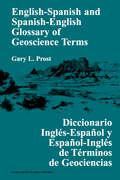- Table View
- List View
Engineering Hydrology for Natural Resources Engineers
by Ernest W. TollnerThis fully revised edition provides a modern overview of the intersection of hydrology, water quality, and water management at the rural-urban interface. The book explores the ecosystem services available in wetlands, natural channels and ponds/lakes. As in the first edition, Part I examines the hydrologic cycle by providing strategies for quantifying each component: rainfall (with NOAH 14), infiltration, evapotranspiration and runoff. Part II examines field and farm scale water quality with an introduction to erosion prediction and water quality. Part III provides a concise examination of water management on the field and farm scale, emphasizing channel design, field control structures, measurement structures, groundwater processes and irrigation principles. Part IV then concludes the text with a treatment of basin-scale processes. A comprehensive suite of software tools is available for download, consisting of Excel spreadsheets, with some public domain models such as HY-8 culvert design, and software with public domain readers such as Mathematica, Maple and TK solver.
Engineering Karstology of Dams and Reservoirs
by Petar MilanovićKarst terrains have been modified and adapted through a range of human activities as the need for flood control, irrigation, food production, hydropower production and other resources has increased. Successful reclamation projects require construction of dams and reservoirs. Karst terrains present the most complex working conditions for dam foundation and realization of safe reservoir space. Practical engineering solutions are extremely complex and the need for successful solution requires serious investigations and the cooperation of a wide spectrum of scientists and engineers. A wealth of data on dam projects in karst has been collected and presented in this book. Since reservoirs in karst may fail to fill despite extensive investigations and remediation treatment the book includes a description of failures as well.
Engineering Reality: The Politics of Environmental Impact Assessments and the Just Energy Transition in Colombia
by Cornelia HelmckeEngineering Reality offers unprecedented insights into the power of environmental impact assessments in engineering a reality favourable to any investment, focusing on the highly contested environmental study of a large hydroelectric dam project in southern Colombia, El Quimbo. The inclusion of environmental impact assessments to project proposals of environmental influence has been an undeniably important step to environmental governance in many countries around the world. Regarding the science behind these studies as objective and their results as the closest in representing reality, however, is misleading. Many activists and scholars made it their mission to uncover the limitations and work towards filling the gaps. Participation processes are considered key to any successful evaluation, but local knowledges and alternative perspectives are still often disqualified through more widely accepted scientific methods. Engineering Reality systematically walks through and accounts for the shortcomings and injustices associated with environmental monitoring. It compares the reality as presented in the dam’s environmental impact study with first-hand accounts from the local and affected populations and observations gathered through two periods of fieldwork in 2012 (before) and 2016-17 (after the dam started operating). It explores how the knowledge of the study was used politically and to what end. Bringing the findings in conversation with the wider environmental impact assessment literature, the book proposes a new framework to assess energy projects -Energy Data Justice- that regards the environmental impact assessment a strictly political tool aimed at reaching the just energy transition in Colombia and worldwide.
Engineering Research Infrastructures for European Synergies: Proceedings of ERIES-IW2025 (Lecture Notes in Civil Engineering #718)
by Gian Michele Calvi Gerard J. O’ReillyThis open access book highlights the latest advances, innovations, and applications in the field of earthquake engineering, as presented by leading international researchers and engineers at the International Workshop in Engineering Research Infrastructures for European Synergies (ERIES-IW), held in Lisbon, Portugal, on May 7–9, 2025. The event was meant to provide a unique platform to exchange experiences, share results, and explore future directions in seismic, wind, and geotechnical engineering research, with a focus on reducing hazard-related losses, managing risk, and fostering sustainable solutions. The contributions, which were selected by means of a rigorous international peer-review process, present a wealth of exciting ideas that will open novel research directions and foster multidisciplinary collaboration among different specialists.
Engineering Response to Climate Change
by Robert G. WattsA clear, concise discussion of today's hottest topics in climate change, including adapting to climate change and geo-engineering to mitigate the effects of change, Engineering Response to Climate Change, Second Edition takes on the tough questions of what to do and offers real solutions to the practical problems caused by radical changes in the Ea
Engineering Surveys for Industry
by Alojz Kopáčik Ján Erdélyi Peter KyrinovičThis book is the translated English version of a text on industrial surveys, originally published in Slovak by SPEKTRUM STU Publishing. This updated version is not only a translation of the original, but also a reviewed, extended version, which reflects up-to-date international standards and regulations. The book covers topics in engineering surveying not available in other publications in this complex form, and addresses the design methodology, data processing and implementation of geodetic measurements under specific conditions to make industrial work environments safer and more efficient. The book begins by introducing readers to these conditions, and then discusses design of maps, geodetic networks and information systems of industrial plants, the usage of cartesian and polar coordinate measuring systems, terrestrial laser scanning technology, as well as measurement of cranes, rotary kilns and special objects of nuclear power plants. The book will be of use to teachers, students, practitioners (e.g. surveyors), quality production managers, equipment designers and mechanical engineers.
Engineering Sustainable Life on Earth: Alleviating Adverse Climate Change Through Better Design
by John F. CoplinClimate scientists have clarified the main causes of climate change, and the tight timescale within which humans must change behaviour, and implement effective solutions, wherever they are needed across the world. This book uncovers many of the powerful actions and uses them effectively to achieve sustainable human life, of improved quality, in a way that is affordable out of earned income for all humans, wherever they live. The ultimate solution to climate change lies not just in doing and consuming less but does instead entirely revolve around our ability to "out innovate" the problem. John F. Coplin, CBE, FREng, FCGI, has had a long and distinguished career in engineering and has operated and advised at all levels from heads of state, company chairs, engineering directors, government advisory boards, and on the shop floor. He is perfectly placed to take a wide-ranging approach, applying modern design and innovative engineering at a systemic level in order to provide novel approaches that will have far-reaching impact on reversing humankind’s impact on this planet. His projections and solutions are based on facts, reasonable calculations, and science learnt from nature. Unafraid to challenge current thinking, John looks at solutions across multiple sectors, including aviation, cars and domestic local transport, clean and renewable energy, food and agriculture, and housing and communities, and describes the particular potential of hydrogen as fuel. The book is written in a language for all. It is small enough to be used is a practical guide to where some of the most useful improvements are to be found and as a way to start important conversations.
Engineering Vulnerability: In Pursuit of Climate Adaptation
by Sarah E. VaughnIn Engineering Vulnerability Sarah E. Vaughn examines climate adaptation against the backdrop of ongoing processes of settler colonialism and the global climate change initiatives that seek to intervene in the lives of the world’s most vulnerable. Her case study is Guyana in the aftermath of the 2005 catastrophic flooding that ravaged the country’s Atlantic coastal plain. The country’s ensuing engineering projects reveal the contingencies of climate adaptation and the capacity of flooding to shape Guyanese expectations about racial (in)equality. Analyzing the coproduction of race and vulnerability, Vaughn details why climate adaptation has implications for how we understand the past and the continued human settlement of a place. Such understandings become particularly apparent not only through experts’ and ordinary citizens’ disputes over resources but in their attention to the ethical practice of technoscience over time. Approaching climate adaptation this way, Vaughn exposes the generative openings as well as gaps in racial thinking for theorizing climate action, environmental justice, and, more broadly, future life on a warming planet.Duke University Press Scholars of Color First Book Award recipient
Engineering and Communications in Antarctica: Enabling Technologies in Antarctica (Springer Transactions in Civil and Environmental Engineering)
by Neloy KhareIndia launched its maiden scientific expedition to Antarctica way back in 1981 and ever since annual expeditions are launched to address thematic research in the contemporary areas of Antarctic Science and Engineering. The initial efforts and achievements of India are not only significant but are of historical importance.This book discusses a wide array of topics that have entered the mainstream of geotechnical and geo environmental engineering over the initial two and half decades of India’s presence in the icy continent ‘Antarctica’. At the same time, it highlights the lessons learnt in cryo-engineering technologies. It covers various articles on many aspects of environmental science and collates the overall achievements in the fascinating field of Antarctic engineering and environmental impact assessment. Accordingly, this book covers articles on wind energy by Ramesh et al., and engineering aspects in Antarctica by Rai. Similarly, Pathak has reviewed the engineering details of Dakshin Gangotri and Maitri. On the contrary, Sharma has provided an interesting history about the process of establishment of Dakshin Gangotri station. Similarly, communication aspects have been highlighted by Dhaka. Commercial polymers and their utility in cold region have been discussed by Dabholker et al. Besides, Tiwari and Khare have reviewed the environmental studies carried out during the initial 25 years in Antarctic research base ‘Maitri’. Similarly, Ramchandran and Sathe have studied the natural radioactivity in Antarctica while fire safety in Antarctica has been touched upon by Chatterjee. On the other hand, Veerbhadraiah and Jain have provided a status on environmental management services at Maitri station Additionally Tiwari has provided details on the new Indian Research Base ‘Bharti’ at Larsemann Hills region. It provides a one-stop reference for researchers and those working in industry and government.
Engineering and Ecosystems: Seeking Synergies Toward a Nature-Positive World
by Bhavik R. BakshiThis book demonstrates how the inclusion of nature in engineering decisions results in innovative solutions that are economically feasible, ecologically viable, and socially desirable. It advances progress toward nature-positive decisions by protection and restoration of ecosystems and respect for ecological boundaries. The topic of this book is an active area of academic research, and leading companies are including goals associated with ecosystem services in their sustainability plans. This book is the first collection of methods and applications that explicitly include the role of nature in supporting engineering activities and describes the role that ecosystems play in supporting technology and industry. It describes approaches, models, applications, and challenges for innovation and sustainability that will be useful to students and practitioners.
Engineering for Earthquake Disaster Mitigation
by Masanori HamadaEarthquake and tsunami disasters have been increasing rapidly and globally in the last quarter-century. The purpose of this book is to provide essential knowledge and information on the mitigation of earthquakes and tsunamis for graduate students, young researchers, and geotechnical engineers. It begins by presenting recent cases of earthquakes that have occurred in the world, referring to tsunamis and soil liquefaction and how to cope with such disasters. The final chapter proposes strategies for disaster mitigation against in Japan earthquakes and tsunamis in the future.
Engineering for Extremes: Decision-Making in an Uncertain World (Springer Tracts in Civil Engineering)
by Mark G. Stewart David V. RosowskyThe volume explains how risk and decision-making analytics can be applied to the wicked problem of protecting infrastructure and society from extreme events. There is increasing research that takes into account the risks associated with the timing and severity of extreme events in engineering to reduce the vulnerability or increase the resiliency of infrastructure. "Engineering for extremes" is defined as measures taken to reduce the vulnerability or increase the resiliency of built infrastructure to climate change, hurricanes, storms, floods, earthquakes, heat waves, fires, and malevolent and abnormal events that include terrorism, gas explosions, vehicle impact and vehicle overload. The book introduces the key concepts needed to assess the economic and social well-being risks, costs and benefits of infrastructure to extreme events. This includes hazard modelling (likelihood and severity), infrastructure vulnerability, resilience or exposure (likelihood and extent of damage), social and economic loss models, risk reduction from protective measures, and decision theory (cost-benefit and utility analyses). Case studies authored by experts from around the world describe the practical aspects of risk assessment when deciding on the most cost-efficient measures to reduce infrastructure vulnerability to extreme events for housing, buildings, bridges, roads, tunnels, pipelines, and electricity infrastructure in the developed and developing worlds.
Engineering for Sustainable Development and Living: Preserving a Future for the Next Generation to Cherish
by Jacqueline A. Stagner David S-K. TingWhat can we do to preserve a future for the next generation to cherish? A potent answer is to exercise good stewardship in realizing more sustainable living and development. This volume brings together experts from around the world to disseminate the late
Engineering, Science, and Sustainability: Advancements in Technology and Techniques
by Dimitrios A Karras Sai Kiran Oruganti Sudeshna RayISC 2022 is dedicated to the Niti Aayog policies to promote sustainability through exchange of ideas emerging out of the academia. The ISC is an annual conference that is held in virtual mode until COVID restrictions on travel exist. The vision of the conference is to capacitate Academia with the necessary ideas that provide insights of the grassroot level development to various stakeholders of the Niti-Aayog policies. Towards this goal, the conference creates a conjunction of various stakeholders of Niti-Aayog policies that include- academic institutions, government bodies, policy makers and industry. The ISC organizers make concerted efforts to promote academic research that would technological, scientific, management & business practices, and insights into policy merits & disruptions. The framework of exchange of ideas is geared towards adoption of deep technologies, fundamental sciences & engineering, energy research, energy policies, advances in medicine & related case studies. This framework enables the round table discussions between the academia, industry and policy makers through its range of plenary and keynote speakers.
Englad's Sea Empire, 1550-1642 (Routledge Revivals)
by David B. Quinn A N RyanFirst published in 1983, England’s Sea Empire was originally part of the Early Modern Europe Today book series. It explores the relationships between the increase of English merchant shipping, the growth of naval power and the early experiments in overseas trade and colonisation. No other book combines these topics for the period from the middle of the 16th to the middle of the 17th century. In dealing with economic, strategic and technical problems, the authors write in language which is intelligible to non-specialist readers. They illustrate the arguments with generous quotations from contemporary sources and with maps of the regions under discussion. This book will be of value on undergraduate courses in early British or colonial or maritime history.
England and the Discovery of America, 1481-1620: From the Bristol Voyages of the Fifteenth Century to the Pilgrim Settlement at Playmouth: The Exploration, Exploitation and Trial-and-Error Colonization of North America by the English (Routledge Revivals)
by David B. QuinnFirst published in 1974, England and the Discovery of America places the early explorations of the English in North America in the broad context of 15th and 16th century history. Marshalling evidence that cannot be pushed aside and sifting a mass of fascinating detail (including problems of cartography and the Vinland Map controversy), Professor Quinn presents circumstantial indications pointing to 1481 as the date or the discovery of America by Bristol voyagers – fishermen seeking new sources of cod, and merchant sailors with maps carrying promise of unexploited Atlantic islands. Whereas England did little to follow up her early lead, Quinn demonstrates that English initiatives from the 1580s onward, though slow, were of great importance. He brings to life the men involved in a variety of rash and heroic experiments in colonization and casts new light on their fates. He makes it clear that it was this very profusion of trial and error and trail again, as well as the conviction that settlement in temperate latitudes in North America could be effective if tenaciously enough sought, that enabled the English to strike and maintain routes in their new American world. This book will be of interest to students of English history, American history, colonial history and naval history.
England: The Land
by Erinn Banting<P>England's landscape is rich in beauty and dotted with history. From the breathtaking Lake District to the southern downs, take a journey across England. <P>[This text is listed as an example that meets Common Core Standards in English language arts in grades 4-5 at http://www.corestandards.org.]
English Urban Commons: The Past, Present and Future of Green Spaces (Earthscan Studies in Natural Resource Management)
by Sarah Collins Rachel Hammersley Christopher Rodgers Emma Cheatle Olivia Dee Alessandro Zambelli John Wedgwood Clarke Siobhan O’NeillThe book presents a novel examination of urban commons which provides a robust base for education initiatives and future public policy guidance on the protection and use of urban commons as invaluable urban green spaces that offer a diverse cultural and ecological resource for future communities. The book's central argument is that only through a deep understanding of the past and a rigorous engagement with present users, can we devise new futures or imaginaries of culture, well-being and diversity for the urban commons. It argues that understanding the genesis of, and interactions between, the different pressures on urban green space has important policy implications for the delivery of nature conservation, recreational access and other land use priorities. The stakeholders in today’s urban commons, whether land users, policy makers or the public, are the inheritors of a complex cultural legacy and must negotiate diverse and sometimes conflicting objectives in their pursuit of a potentially unifying goal: a secure future for our urban commons. The book offers a unique and strongly interdisciplinary study of urban commons, one that brings together original historical investigation, contemporary legal scholarship, extensive oral history research with user groups, and research examining the imagined futures for the urban common in modern society. It explores the complex social and political history of the urban common, as well as its legal and cultural status today, using four diverse case studies from within England as exemplars of the distinctively urban common. These are Town Moor in Newcastle, Mousehold Heath in Norwich, Clifton and Durdham Downs in Bristol and Valley Gardens in Brighton. The book concludes by looking forward and considering new tools and methods of negotiation, inclusivity and creativity to inform the future of these case studies, and of urban commons more widely. This book will be of great interest to students and scholars of the commons, green spaces, urban planning, environmental and urban geography, environmental studies and natural resource management.
English Urban Commons: The Past, Present and Future of Green Spaces (ISSN)
by Sarah Collins Rachel Hammersley Christopher Rodgers Emma Cheatle Olivia Dee Alessandro Zambelli John Wedgwood Clarke Siobhan O’NeillThis book presents a novel examination of urban commons which provides a robust base for education initiatives and future public policy guidance on the protection and use of urban commons as invaluable urban green spaces that offer a diverse cultural and ecological resource for future communities.This book's central argument is that only through a deep understanding of the past and a rigorous engagement with present users can we devise new futures or imaginaries of culture, well-being and diversity for the urban commons. It argues that understanding the genesis of, and interactions between, the different pressures on urban green space has important policy implications for the delivery of nature conservation, recreational access and other land use priorities. The stakeholders in today’s urban commons, whether land users, policy makers or the public, are the inheritors of a complex cultural legacy and must negotiate diverse and sometimes conflicting objectives in their pursuit of a potentially unifying goal: a secure future for our urban commons. This book offers a unique and strongly interdisciplinary study of urban commons, one that brings together original historical investigation, contemporary legal scholarship, extensive oral history research with user groups and research examining the imagined futures for the urban common in modern society. It explores the complex social and political history of the urban common, as well as its legal and cultural status today, using four diverse case studies from within England as exemplars of the distinctively urban common. These are Town Moor in Newcastle, Mousehold Heath in Norwich, Clifton and Durdham Downs in Bristol and Valley Gardens in Brighton. This book concludes by looking forward and considering new tools and methods of negotiation, inclusivity and creativity to inform the future of these case studies, and of urban commons more widely.This book will be of great interest to students and scholars of the commons, green spaces, urban planning, environmental and urban geography, environmental studies and natural resource management.The Open Access version of this book, available at www.taylorfrancis.com, has been made available under a Creative Commons [Attribution-Non Commercial-No Derivatives (CC-BY-NC-ND)] 4.0 license.
English Urban Life: 1776-1851
by James WalvinThe years between 1776 and 1851 are of profound importance for the social and urban historian. English town dwellers of the period experienced some fundamental changes in their way of life: rapid population growth; and an unprecedented rate of social change resulting from this. These ever-increasing armies of town dwellers presented the local and central authorities with a myriad of urgent problems, including those of feeding, housing and controlligni a turbulent populace. These years saw the emergence of a new, essentially modern, machinery of control for running an urban society. Despite these dramatic changes an equally important feature of the period was the elements of continuit - in work, family life and leisure. Part one deals with the physical changes, the problems for the town dweller inherant in these, and the distinctions of social class that developed. Part two discusses the political response to the urbanization of England and the problems this caused: poverty and law enforcement. In part three the continuities are assessed: in leisure, rituals and family life. At every opportunity Dr Walvin brings his material to life with his extensive use of contemporary commentaries. In this lively and wide-ranging study, firmly rooted in recent scholarly research, Dr Walvin provides a balanced and up-to-date picture of a society which, although experiencing the most fundamental changes was also characterized by the continuities in its people's habits and social customs. This book was first published in 1984.
English Wetlands: Spaces of nature, culture, imagination
by Andrew Church Mary Gearey Neil RavenscroftThis book argues that to understand wetlands is to understand human development. Using case studies drawn from three English wetlands, the book moves between empirical research and scholarship to interrogate how these particular ecosystems have played an essential part in the development of our contemporary society; yet inhabit a strange place in our national psyche. Chapters address a range of cultural and environmental wetland concerns. Consideration is given to: the ways in which we have revered, engineered and renaturalised these landscapes throughout history; English wetlands as spaces of beauty, creativity, reflection, rejuvenation and multi-species interactions; accelerating climate change in an age of neoliberalism. The final chapter then is a reflection on our collective lives together alongside other species, exploring what sustainability transitions might mean for human-wetland relationships.
English for Common Entrance at 13+ Exam Practice Answers
by Amanda Alexander Rachel GeeThis book contains answers to all the questions in English for Common Entrance at 13+ Exam Practice Questions, accompanied with extensive advice and guidance to help achieve top marks.- Endorsed by Independent School Examination Board (ISEB)- Clean, clear layout for easy marking- Identifies areas requiring further attentionAlso available in the English for Common Entrance at 13+ range:- English for Common Entrance at 13+ Revision Guide (ISBN: 9781471875021)- English for Common Entrance at 13+ Exam Practice Questions (ISBN: 9781471868962)
English for Common Entrance at 13+ Exam Practice Questions
by Amanda Alexander Rachel GeeThis book provides a wealth of comprehensive practice exercises in the format of the ISEB Common Entrance exam at both Level 1 and 2. A varied selection of texts and poems has been selected to help pupils for the Reading sections of the exam, and there is a large bank of exercises for the Writing sections.Exam Practice Answers is available to accompany this title.- Endorsed by Independent School Examination Board (ISEB)- Features rigorous and realistic exam-style questions in the style of the ISEB Common Entrance exam - Provides extensive practice and guidance to help pupils achieve top marksAlso available in the English for Common Entrance at 13+ range:- English for Common Entrance 13+ Revision Guide (ISBN: 9781471875021)- English for Common Entrance Exam Practice Answers (ISBN: 9781471868993)
English for Common Entrance at 13+ Revision Guide
by Susan ElkinAn essential revision resource for pupils working towards English Common Entrance at 13+. A full colour resource which holds the most up-to-date material and exam techniques. Throughout the book you will find revision tips and practical guidance on how to achieve top grades, as well as self- assessment questions to help pupils identify areas that need further study.- Endorsed by Independent School Examination Board (ISEB)- Consolidates all the key information required for Common Entrance at 13+- Provides practical guidance on improving written answers and exam technique- Includes advice on creative writing and how to write for practical purposes
English-Spanish and Spanish-English Glossary of Geoscience Terms
by Gary L. ProstThis glossary provides a ready reference to those in the geosciences with the need to translate from English to Spanish or vice versa. It also provides clear communication, a better understanding, and closer working relationships among geoscientists, engineers, and businessmen.
